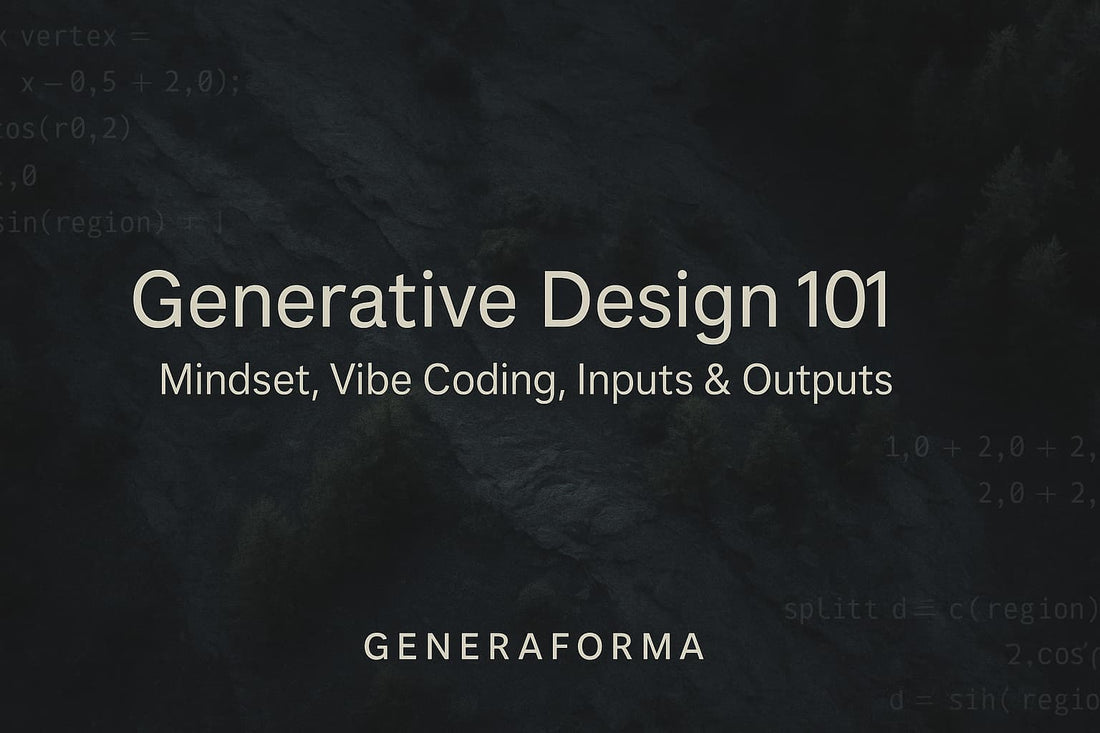
Generative Design 101: Mindset, Vibe Coding, Inputs & Outputs
Share
Generative Design 101: Mindset, Vibe Coding, Inputs & Outputs
At GENERAFORMA, design isn’t drawn—it grows. Generative design replaces a single, final sketch with a living system of rules and constraints that lets forms emerge, adapt, and evolve. Instead of authoring one object, you author the conditions for many possible objects, then select the ones that satisfy function, fabrication, and feeling. This approach is widely used in industry to explore large solution spaces under designer-defined criteria.
From static sketches to systems that grow
Traditional design moves in a straight line—imagine, draw, refine, ship. Generative design moves in loops: set goals and constraints, generate candidates, read what the system produced, adjust, regenerate. The computer becomes a partner that explores the space of possibilities you’ve framed; craft lives in choosing variables, balancing freedom and constraint, and deciding what “good” means for performance and expression. This definition—as an algorithmic, criteria-driven exploration—matches authoritative descriptions used in professional software and practice.
What “vibe coding” means today
Vibe coding is the emerging practice of building software by talking to AI. You describe behavior in natural language, the model generates code, you run it, then you ask for refinements—an iterative dialogue where prompts shape architecture, UI, and logic. It lowers barriers for non-engineers and accelerates prototyping for experts; the developer’s role shifts from typing every line to specifying intent, constraints, and acceptance criteria. This isn’t folklore: the term and method are now documented by major vendors and press, and even productized in tools that let you “vibe-build” full apps from a phone.
Vibe coding is powerful but not magic. You still need to structure prompts, test results, and reason about files, dependencies, and security. Like any new workflow, it shines when you constrain scope, define “done,” and keep a tight feedback loop between specification (your prompts) and validation (your tests). The conversation replaces boilerplate, not engineering judgment.
Inputs: the nutrients of growth
Generative work thrives on inputs that feed structure and variation. Seeds make randomness reproducible, so you can recreate or branch a result at will. Noise fields add smooth, correlated variation—the kind that feels natural in terrains, folds, and stratified textures—rooted in decades of graphics research from Ken Perlin’s seminal work onward. Beyond stochastic inputs, you can drive form with images (luminance → height), tabular data (CSV/JSON → radius or density), or live signals (sound, temperature) for pieces that respond to context.
Outputs: from pixels to printable matter
The same rules can target multiple outputs. On screen you export raster images for documentation; for clean edges or fabrication drawings use SVG/PDF. When you make physical artifacts you’ll typically export meshes (STL/OBJ/3MF) for 3D printing, or toolpaths (G-code) for plotters, CNC, or laser. The logic remains identical; only the final format and tolerances change.
Towards 3D printing: composing with constraints
Printers love continuity and reasonable slopes; they resist thin spikes and deep, unsupported cavities. If your growth is destined for FDM/FFF printing, a few verified principles keep beauty and reliability aligned:
-
Overhangs: as a rule of thumb, FDM handles about 45–60° depending on cooling, material, and settings; steeper regions often need supports and finish differently.
-
Nozzle and layers: the common desktop nozzle is 0.4 mm; maximum layer height ≈ 70–80% of nozzle diameter (≈0.32 mm for 0.4 mm) to maintain adhesion and quality.
-
Clearance & fits: tolerances aren’t universal; start with small test coupons and expect clearances on the order of tenths of a millimeter (range varies by process and material), then refine for your printer/material combo.
-
Material & heat: PLA softens around its glass transition ~55–60 °C; design lamps for LED light (e.g., warm 2700 K) and avoid heat buildup.
These aren’t arbitrary “rules”—they’re grounded in manufacturer knowledge bases and material data sheets. The artistic voice remains yours; constraints help the work arrive intact.
A first growth you can steer
Pick a simple canvas and let a field do the talking. Start with horizontal lines. Sample a smooth field across the page and let it nudge each line up or down; a landscape appears, with broad shoulders where the field runs high and quiet plateaus where it calms. Change the seed and watch a sibling form with the same grammar. Shrink the scale and the land becomes gentler; increase the amplitude and the folds deepen. When a candidate sings, save it, then translate the logic to 3D: revolve a profile for a vase body or loft several curves into a shade, run a printability check, and—if the slicer flags an issue—return to the system and tune the growth rather than patching the mesh.
Reading results with intent
Selection is not “I like it.” It is criteria—for a vase, the rhythm under side light and enough quiet space to frame dried stems; for a lamp, diffusion quality, glare control, and thermal comfort. Keep a grid of candidates with identical framing, exposure, and notes. Record seeds and parameter sets for anything you may revisit. Over time your personal grammar clarifies; variation becomes identity rather than noise.
Where we go next
With the mindset, vibe-coding workflow, and I/O map in place, Lesson 2 will detail seeds, randomness, and noise fields—how to shape natural variation you can control, from calm one-octave terrains to rich multi-octave morphologies, always with fabrication in view.
